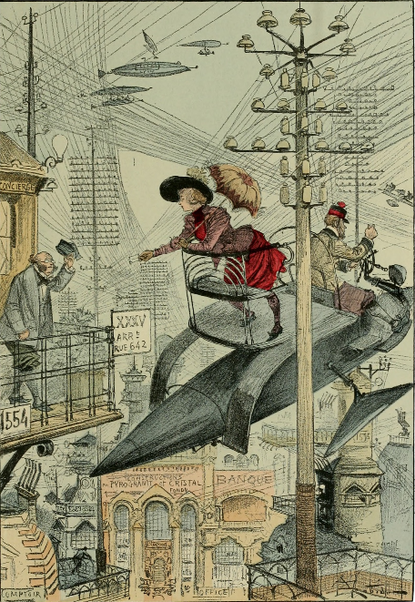incertae sedis with Brittany Ransom
In incertae sedis interview series we will discuss trends that are becoming more noticeable within the new media arts.
In Latin, incertae sedis means "of uncertain seating". This term is used in biology to indicate species with an uncertain position, which scientists find difficult to define. While taking on and experimenting with imprecise still hybrid forms, new media arts are in the same indefinite situation nowadays. They blur boundaries between science, technology, direct involvement of viewer in the process of generating the art piece, and a conceptual approach towards creative framing of the artistic gesture. Despite its mutant origins that could cause a distance between the artwork and audience at the beginning, these transgressive genres of art reveal new social symptoms. The haziness and vagueness of formal apparatus of the new media arts exposes artists’ concern about new available tools and independence of art as an autonomous zone. This series of interviews was also planned as an attempt to reflect on what equipment do contemporary galleries and exhibition spaces need to acquire. Furthermore, in conversations with artists we will try to clarify what types of art-residencies and educational programs do we need to develop on the territory of hybrid arts in a bid to preserve a ‘clear’ artistic vision on new social phenomena.
My first conversation for incertae sedis series was with an American artist Brittany Ransom.
Brittany uses technologies and programming to create new dialogues between human and animal, and natural environment. She teaches courses on video art and hybrid/digital media at the Meadows School of Art at Southern Methodist University in Dallas, TX. Her projects are usually performed by termites, cockroaches and other animals, sometimes by plants. At a current phase these artworks remind me early depictions of animals on frescos and sculptures in European cathedrals. They are still a bit schematic and portray more the artist’s fantasies rather than precisely studied characteristics and abilities of animals. Brittany Ransom’s artworks evolve around the idea of Other whom she is giving typical human tools aiming to reveal some higher abilities of these ‘superorganisms’. Brittany is College Art Association Fellow, she was twice awarded a Lincoln Fellowship (2010, 2011) and got many other awards during her studies at The Ohio State University and The Illinois University in Chicago, where she received her M.F.A. in New Media Arts in 2011.
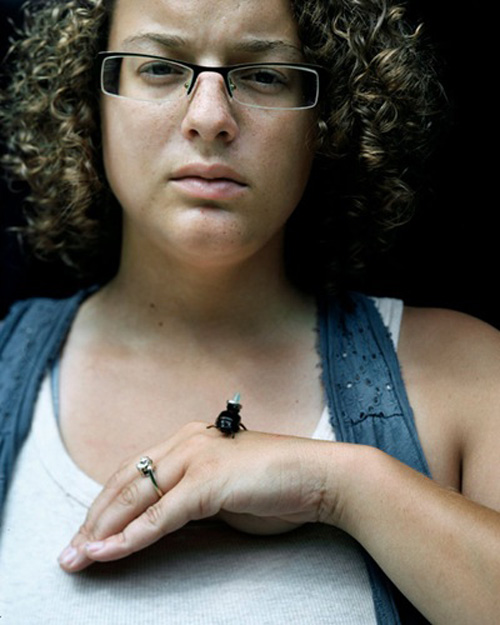
Lilia Kudelia A scholar from the National University of Singapore Denisa Kera says that museums are new bestiaries of the 21st century. She talks about transformations inside arts structure (such as current development of bio art) as well as mutations in the institutional sphere when borders between a museum and a laboratory are often blurred. Kera compared contemporary art&technology institutions to the 17-18th century curiosity cabinets and Medieval Bestiaries emphasizing how curiosity to chimeras and belief in magic intrusions by God had become replaced by the trust in hybridity and possibility of mutations. Brittany, do you think your projects should be shown in ‘the Bestiary for the 21st century’?
Brittany Ransom I think about that a lot. The goal of many of my pieces and projects is to blur the line between what is art and what is science, and what an artist studio and research lab looks like. I really think of the studio as a sort of a lab space. So I completely agree with that scholar. My artworks are the new way of looking at research or at least a way of making research available to a wider audience. I used to work as an exhibition technician at a science museum therefore I think a lot about aesthetics in my pieces and a way I present them.
- What people have an influence on your work?
- When I was at Ohio State University Ken Rinaldo and Amy Youngs were two of my biggest supporters and are now people whom I really admire. They do a lot of work with bio art and nature looking at the environment noise and critiquing the way we use that environment. There are also people like Eduardo Kac who are making more controversial pieces or question the way in which we use science in everyday practices.
- How would you describe your art practice in terms of art genres?
- I’m not sure if I quite consider myself a bio artist. I do work with biology quite frequently. I’m working on pieces that I think will now have more concrete research behind them. I usually say that I am a new media artist. But I have a problem with the term ‘new media’ because none of the media is necessarily new. I think of myself more as a digital artist since I use a lot of digital tools. I am hesitating to call myself a science artist because I’m not scientist, but I do utilize collaboration with a lot of scientists that helps me to put together a lot of research facts to create my pieces.
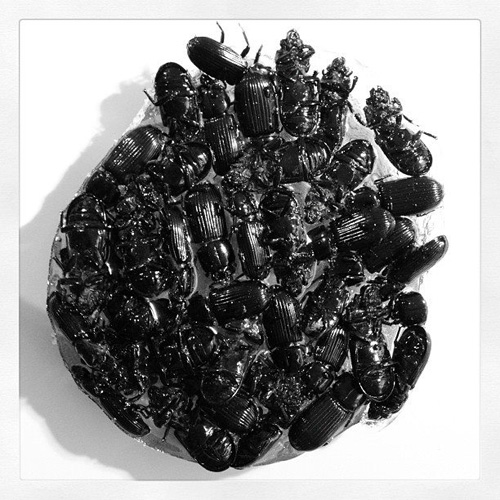
- Do you treat the animal/insect body as a material for your work or as something more complicated? I guess these bodies are a medium for you because you touch various behavioral and ethical issues in your projects. But at the same time there is still a danger of commodification of these bodies because of their evident functional role in an art piece. How do you draw the difference between these two viewpoints?
- I try not to treat animals and insects as a material. Even if they are listed as a material in my pieces, I think of them as my collaborators. But in a sense that I am uninvited collaborator so they don’t necessarily have a will or give me a permission to collaborate with them. When I approach a lot of my works, respecting them and respecting what they need is something that is very important to me. For instance, in the Track Series project with the beetles, the backpacks were made after the beetle. It means that if insects don’t want to wear it any more they are able to wrap up or just loose the backpack. After that they are sort of free.
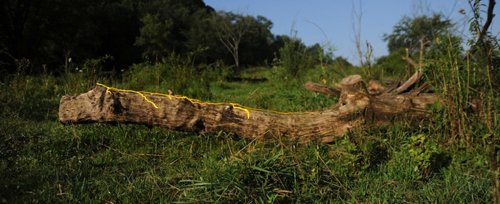
In my TwitterRoach project, which I had recently showed in Chicago, a cockroach is outfitted with a backpack made by Backyard Brains company. And that is completely subversive compared to all other sorts attachments that I have been putting on animals and insects to make my work. The point of the project is to question commercialism in a fact that this kit is commercially available. All of the programming I’m using is completely open source. So I was also interested in the ‘collective mind’ of social media like Twitter. What does it mean to give control to an anonymous group of people that are all networked together in this way?
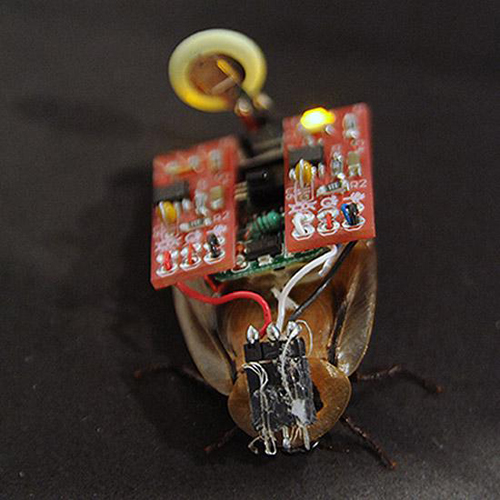
I do think of insects as a material but also as living beings like me and you. It’s really important for me to know and keep a feeling that I am working with a live creature and to respect them.
- Would you agree that some of the projects you create could be considered as animal performances?
- That’s a good question. I have never thought of them as animal performances so much the animal or the insect becomes the final element in making a piece whole. I am interested in giving away my ability to make the piece fully functional and give that control to them. And then to see if they are willing to do it and whether they understand that they are controlling these things. And if they do understand things, I am wondering if they can learn from it or change the way we learn. Looking at insect systems I am also interested in the way they form societies or social bonds. Moreover, I am curious what positive models of food and resources development by insects we can look at as people.
- Do you know about Ollie Palmer’s piece “Ant Ballet” ? This British artist reproduces the pheromone trails ants use to communicate. His idea is to direct them in the medium of dance creating a unique control system to choreograph their movements.
- I guess in a way I can see how some of my pieces look like an animal performance. I did a similar piece where I had used the same pheromone systems but with termites who then followed the Dallas/Fort Worth highway system. And as they are performers, I want to think of people themselves in this everyday performance that they repeat over and over again.
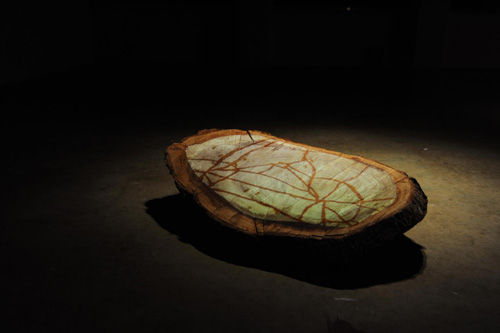
- Could you expand more on the idea of co-evolution?
- Globally as people we are in a strange place right now. Because of having these different technologies our path is in some way excluded from a natural world. I like to use technology as a bridge for us to look at how we could co-evolve together with animals because I think we are going to lose one another sooner or later. But I am always questioning whether or not nature and insects want to do this? If animals could talk they would probably say people are disgusting as a race. I think humans are the biggest pest on the planet. That is what my dad sad. Not me.
- Speaking about the idea of ‘other’ in your projects, I would like to talk about an art piece “Eat Me”. I think that you managed to create a perfect innovative example of a still life. In this installation we are expected to contemplate the eating termites in relation to their food, which is the fundamental category of the still life as a genre. And secondly, we clearly see the idea of birth and death embodied by your birth certificate, which will soon be consumed by termites. Similarly, in European iconography, insects in the still life symbolize the transient nature of life, whereas the abundance of fruits, vegetables, and flowers pointed towards overwhelming consumerism. And finally you draw our attention to the hydrogen, which is crucial for all living beings. This fact points our attentions towards the phenomenon of birth again. What was your primary interest in creating the project “Eat Me”? And do you have any symbolism in mind while working with insects?

- I was starting more from an aesthetic point of view, trying to see if I could listen to termites consuming. This piece was created in a response to me thinking about how much waste I had. I was curious about all these documents that are supposed to be significant to us. Then I would like to reflect on the idea whether termites think of our structures as waste but also food (if they could think). And I was really curious to know how much hydrogen my birth certificate – that first original copy of my identity – contains. How much energy that would worth if I had to break it down and feed it to someone transforming into more useful resource?
I also think of it through the categories of life and death, the birth that can come from deconstructing things. But first of all termites are usually a metaphor for people. And in this piece they reveal how unimportant those papers are when you can break it down and use it as more important resource.
- I am curious about durability of your projects. And how limited are the abilities of insects and animals in your installations in a physical sense?
- Yes, I often get such questions like: “Are they going to escape? Are they going to breed? Are they going to eat our gallery?..”
The abilities of insects are fairly limited. First of all, I order them from the biological supplier online. (This is also interesting to me that in our culture you can order a colony of termites online and have them shipped to your house.) So they are limited for legal reasons. These companies can only send you workers but not the queen, in order they could not repopulate.
I have kept my termite colonies for about 6 months. Cockroaches live infinitely as long as they have food and water. I have kept cockroaches for 2 years. I would not necessarily call them pets. But I do want to respect the fact that I have purchased them to be my collaborators and I keep them alive. If you could determine happiness, I think they are sort of happy in this environment that I create for them.
I haven’t run any shows longer than a month. This is a sustainability issue for my insects since I need to have caretakers at the gallery during the time when I cannot be there. It is an interesting conflict: they need water and food along with being put as a piece in a gallery.
- Do you consider these insects beautiful?
- Yes, I do get weirdly attached to them. They are very beautiful, especially those black beetles that I used in “Track Series”. And I want people to not necessarily have the sense of empathy, but at last wonder about the way insects operate. We should be less thinking about them as something disgusting, but more as about something functional and beautiful.
I think I had a bug obsession since my childhood. My parents were wondering what was going on with me. I used to bring the insects home and hide them in my room. The beetles were especially interesting and seemed to be like small machines for me. They are so wonderfully made, so robust and shiny…
- This is great how you consider your collaborators so beautiful and interesting. But when I think about most of the viewers I realize they might not find such projects attractive. In many cases when coming to watch a science art piece the viewer is expected to necessarily grasp the research context and scientific facts upon the art piece. So this experience may look like reading a biology book. In my view, science art still has to deal with a challenging task of engaging the viewer in the process of contemplating an artwork. But your projects (especially HOST) are quite spectacular. Do you often think about how to engage the viewer in your work and make the project more attractive?


- Within the last 6 months to a year I am thinking about the idea of containers and how to break them down with the purpose of having things in one shared space. It is not necessarily accessible to someone who finds these things really grotesque. But I am trying to present them in an almost one-to-one relationships way. You have to really look at these objects. In my project “Partnered We Are All Pests”, visitors have to lie down on a floor and look inside of a glass window to see insects. In designing projects I am always thinking how to make a human body and an insect body to be involved with one another, not necessarily physically but viscerally in the same space.
During my show in Chicago, for the first time ever I had a gallery not making me keep a lid on the TwitterRoach project. And it was interesting to see how much empathy people had for this cockroach. People who would never touch a cockroach were picking it up, helping it, and talking to it.
I also finished an installation with butterflies that would hatch and rid in our space instead of being in a container, in this sort of a science exhibit. I do think a lot about containment and space, and how to take down the walls but have the piece still functioning. I think that separation into containers allows people to still have fears.

- Since you have approached this touching aspect of your work, let’s talk about your projects involving plants. You have an incredibly touching project called Orificial Resonance where people could talk to plants. It reminds me about the work by Shiho Fukuhara and Georg Tremmel called “Biopresence” (2004). Artists decided to put the complete human DNA information into the DNA of tree. Hence, a tree would carry the biological information of human becoming sort of a living monument to a dead person – like in fairy tales and myths where personages are reborn in the form of a plant. A plant in this case becomes responsive to cultural traditions. Recently you have started a project #tag gardens that will exist in order not only to mark social trends but also be a physical network of “tweeting” plants. Can you speak more about the interchange between bio- and Internet culture in this project?
- I have been working on #tag gardens on and off for about a year already. The Internet culture is a place of growth. It is always expanding, growing and changing… The structures are like the DNA. They have messages and hash tags that are always reflecting something more popular changing to the curve whatever society is thinking.
My initial idea was to have the #tags of all of the top trends of Twitter. By the time I get the seeds there are no more those #tags. But I want to see if they could breed and then make new ones. Physically they cannot make my #tags since these are just physical scars on seeds. When they reproduce the new one it is already a normal seed. However, I wonder whether they start adapting to these physical changes over some time if I keep physically invading the seeds. I am curious if I could make this change genetic. But first of all, I think about nature as network and about the strange network that lives online today. I also reflect about the speed of both of them. How long does it take to grow physically and digitally? How rapid and different those phases are?
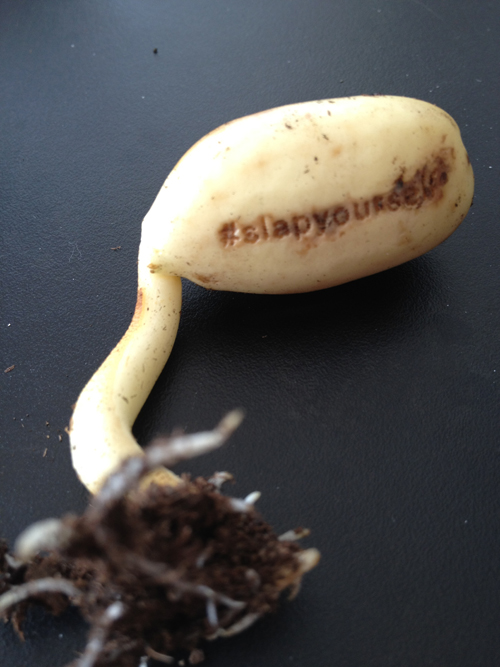
Going back to “Biopresense” project that you have mentioned, it seems interesting for me when people start interfacing their humanism into other species. I am doing this in a way as well. And it often has been rejecting it so far. The plants would grow but the message on the seed got infected with the fungus, and the plant still grows but the message gets moldy. So you cannot see the #tags as if you have erased them. Therefore it is definitely still an experiment.
- Do you have an experiment you have been dreaming about for a long time?
- I am still interested in the idea of termites being used as producers of energy. I am now trying to figure out the way how to harvest the hydrogen they generate. In this case we could literally start partnering with pests to create new models for producing energy.
- How different is the experience of doing your project in a gallery and in an open space (wood) like for example in the Windsolar Sound project?
- I find myself working in a studio and a lab a lot, but drawing inspiration and gathering research from the outside. I made Windsolar Sound pieces during aresidency having my all studio outside. It is a lot harder for me to work outside in a good way. It is challenging, because despite these systems seem controlled in a coded and technical sense, it looks like part of me is losing control over it when I take them outside. And I like that.
- In your view, How should the ideal residency for bio artist look like today?
- The ideal residency… I don’t know if there is an ideal residency. For me it is important to be outside along with being a part of what I am critiquing the human about. A place that allows making outdoors and inside your studio would be a really favorable place for me.
There is one interesting residency in Arctic called Arctic Circle. Part of the angle of it is that it is open to scientists, artists, educators, researchers, and creative people. They sail the Arctic for 2 weeks doing specific research projects together. This is another important thing for me. I believe that residencies need to be opened to more than just one specific network of art people. I like to imagine residency as a thinking space. I like being in places where writers, dancers, scientists, and others gather together.
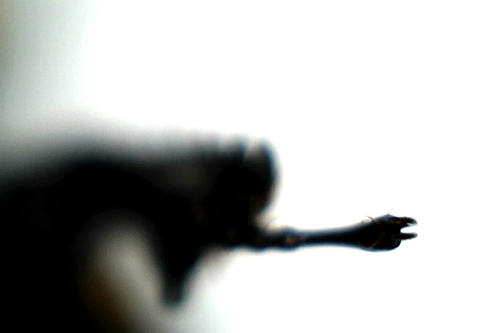

Lilia Kudelia



